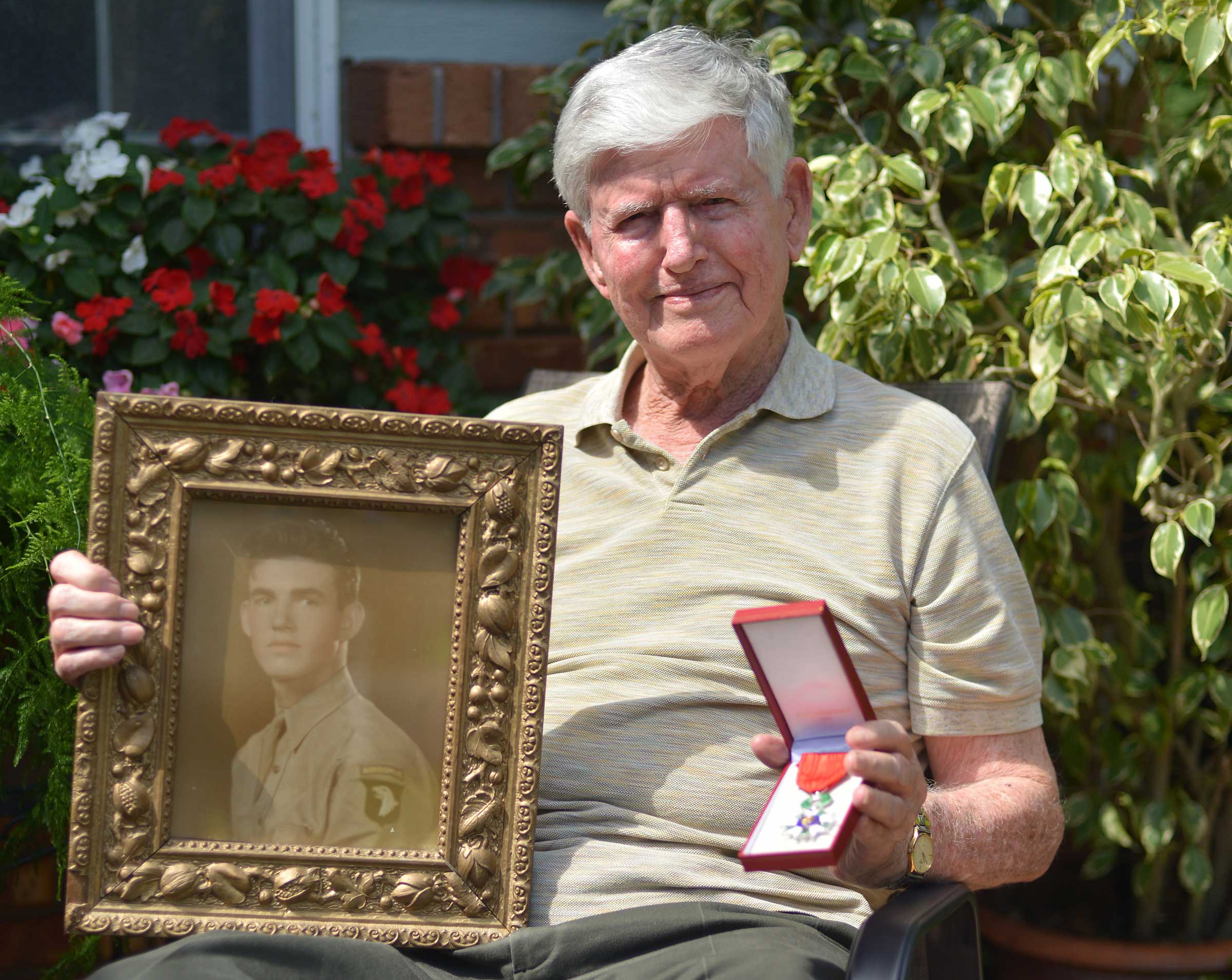Nearly 20 years after the D-Day invasion in Normandy, Harry Nivens of St. Cloud was walking down the hallway of a San Francisco hotel when he saw a familiar face. It was Sergeant Woody Cummings, one of his friends from the 502nd parachute infantry in the 101st airborne division. They were both there for a reunion but Cummings didn’t expect to see his friend.
“He runs up and hugs me,” Nivens remembers. “He says, ‘I thought you were dead,’ and he pulls out a piece of parachute cloth that someone from my company had written down the names of all the men that were killed. My name was on it.”
In the confusion of combat, someone got it wrong. Nivens survived the battlefields of Normandy. Although the memories are painful, he remembers the friendships he made and lost in those battlefields.
Preparing for War
Nivens enlisted in the U.S. Army in January of 1942 when he was 19 years old. He voluntarily joined the airborne division partly because soldiers with parachute jump status received an extra $50 a month, but also, he jokes, because “you had to be a little crazy to get into it.” During his time in jump training, he developed a close friendship with Emmitt Nix and Neil Owens.
Nivens remembers a time in Tennessee when their unit was practicing large-scale maneuvers and he got a bit rebellious with Nix. During these training exercises, their environment mimicked what was to be expected in Europe so their meals left much to be desired. The pair heard that they would get a hot meal if the opposing forces captured them. The thought of a nice, hot meal gave them an idea. “One day we were behind the lines and we allowed ourselves to be captured by the other forces but we didn’t get any warm meals. We got the same old K rations,” Nivens says with a laugh.
A short time later, an enemy Jeep approached their group and set off a machine gun round. According to the rules, they should have allowed the enemy to take them prisoner. Remembering the lack of a hot meal, the friends bolted, jumping over a nearby fence to escape. It’s memories like these – the ones that make Nivens smile – that help to at least partially soothe the sting of the loss that was to come later.
Fast forward to D-Day morning. Nix, Nivens, Owens, and the rest of their unit were inside a plane ready to put several months worth of training into action. The young men had left their families behind to step onto the world stage in Normandy, into one of the bloodiest battles of World War II. “I really don’t think I had too many thoughts at that time. I think our thoughts, or at least mine, were concentrating on doing the job that we were supposed to do,” he says.
In the Trenches
For the 18 men in that plane, the designated drop zone was miscalculated and their landings were scattered. Nivens and Nix found each other and made their way to Saint-Mere-Eglise, the first town liberated in the invasion. With the assistance of a Frenchman, a map and a paratrooper who knew the language, they were able to determine their location and the best route to Utah Beach, their original landing zone.
Several days later, on June 10, 1944, the men and their unit were making their way to Carentan with orders to seize the town. Along the route, they came across a crumbled bridge. One at a time, they crossed a footbridge that had been rigged by their battalion commander all while under sniper fire. Once Nivens crossed, he saw Nix lying ahead of him. A bullet had pierced his body and propelled him into the water. Without skipping a beat, Nivens pulled him onto the bank and cut his shirt open to assess the wound. “When I cut the shirt open the bullet was inside the shirt,” he remembers. “It had enough power to go through his body but it didn’t have enough power to penetrate his shirt. I thought he was going to be alright. I took the bullet and put it in his hand and I told him, ‘Hang on to this for a souvenir.’”
Nivens called for a medic for his friend and continued advancing. Without Nix by his side, his unit experienced bombings by enemy planes, a bayonet charge on the Germans, and plenty of enemy fire. Eventually, he took cover with Celso Garcia in a ditch down the street from the farmhouse they had just charged. Garcia crawled from the ditch to a trooper who was lying in the road. When he returned, he reported to Nivens that the man in the road was Owens and that he had been killed.
It was in that ditch that Nivens received the blow that would take him out of the battlefields for good. “I was hit by machine gun fire while I was standing up firing. After I was hit, I was laying in the road. I was real thirsty so I took my canteen out to take a drink of water … and a bullet had gone through my canteen from top to bottom sometime prior to that so I had no water,” he says. Garcia found a carton of Carnation milk that had been left behind by German soldiers and punctured it with his bayonet for Nivens. “That was some of the best milk I’ve ever tasted,” he remembers.
Four hours later, Nivens was evacuated to a first aid station, where he learned Nix didn’t make it. He was then transported to a hospital station near Utah Beach, which was more equipped to handle his wounds. It was there that he had what he describes as an out-of-body experience due to the heavy blood loss. “It was like I had this sensation that I was above my body looking down at two medics working on me,” he explains. “It was like I was in a tunnel with a light at the end of it, a very peaceful feeling.” It took years before he relayed this experience to others.
He was flown back to England, where he was fitted with a body cast and a steel pin through his right knee and left ankle. Once back in the U.S. it took months for his physical wounds to heal but even longer for the emotional wounds to settle. Even 70 years later, those memories haven’t faded much.
Living With the Aftermath
Nivens named his son Theodore Neil Owens after his two best friends who never made their way home from Normandy; Theodore for Emmitt Theodore Nix and Neil for Cornelius Owens. Some may consider him a hero but he doesn’t. “Well, I’ve never thought the ones that came back were heroes,” he says, choking up on the words. “I mean, they were, but the ones that are still there are the heroes.”
Over the years, Nivens has tried to contact the families of the men that died in Normandy and the battles that followed, to pass on what he knew about the circumstances surrounding their deaths. He tells the story of a Pennsylvania man who had no idea why his cousin was buried in England when he supposedly died in the Holland jump. After researching, Nivens found out the man’s cousin was standing at the door of the plane, ready to make the jump, when he was killed by anti-aircraft fire. His lieutenant pulled him back in and he was flown back to England after the rest of his company safely exited the aircraft. Due to wartime confusion, he was buried in England.
How does Nivens feel about having the opportunity to help these families understand what happened to their loved ones? “It’s gratifying,” he says. “Because most of them just received a telegram.”
Nivens received his own closure after years of searching for the family and burial site of Owens. Five years of searching the Internet, calling anyone he found with the same name as Owens’ brother Richard, and enlisting the help of others culminated in a reunion of the Owens family and Nivens in the final resting place of his friend: a cemetery in Brooklyn, New York. He was able to share with them what happened to their relative in Normandy and introduce them to a family member they would never know.
In the 70 years that have passed since the Normandy invasion, Nivens has re-visited the battlefields and reunited with old comrades. He has been to the World War II Memorial in Washington D.C. and was included in a documentary for the History Channel called “Band of Brothers.” Recently, he was awarded the “Knight of the Legion of Honor” medal from France, the country’s highest distinction. He survived a pivotal moment in America’s history and is one of few that can share his experiences firsthand to keep the memories alive for future generations.







Comments